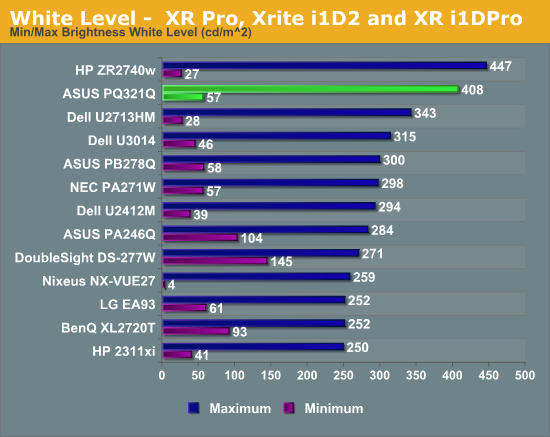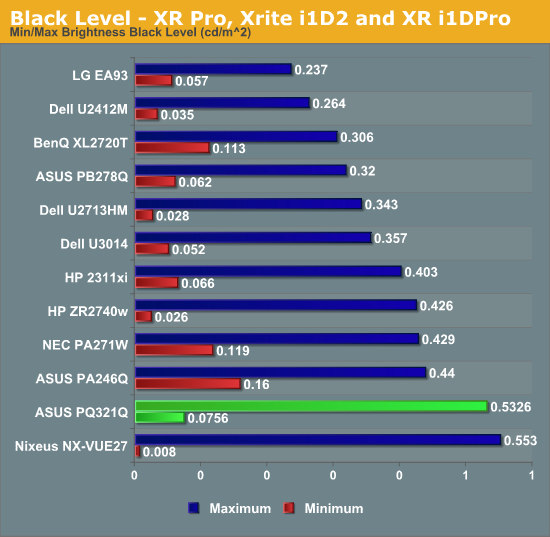ASUS PQ321Q UltraHD Monitor Review: Living with a 31.5-inch 4K Desktop Display
by Chris Heinonen on July 23, 2013 9:01 AM ESTSince the ASUS has a pair of HDMI inputs, but there is effectively no 4K HDMI content right now, the performance of the internal scaler is essential to know. To test it, I use an Oppo BDP-105 Blu-ray player and the Spears and Munsil HD Benchmark, Version 2. The Oppo has its own 4K scaler so I can easily compare the two and see how the ASUS performs.
First off, the ASUS is poor when it comes to video processing. Common film and video cadences of 3:2 and 2:2 are not properly picked up upon and deinterlaced correctly. The wedge patterns are full of artifacts and never lock on. With the scrolling text of video over film, the ASUS passed which was strange as it fails the wedges. It also does a poor job with diagonals, showing very little if any filtering on them, and producing lots of jaggies.
Spears and Munsil also has a 1080p scaling pattern to test 4K and higher resolution devices. Using the ASUS scaler compared to the Oppo it had a bit more ringing but they were pretty comparable. This becomes very important for watching films or playing video games, as you’ll need to send a 1080p signal to get a 60p frame rate. 24p films will be fine, but concerts, some TV shows and some documentaries are 60i and would then appear choppy if sent at 4K over HDMI.
Brightness and Contrast
In our preview of the PQ321Q, we looked at how it performed out of the box with the default settings. What we did see is that the PQ321Q can get really, really bright. Cranked up to the maximum I see 408 cd/m2 of light from it. That is plenty no matter how bright of an office environment you might work in. At the very bottom of the brightness setting you still get 57 cd/m2. That is low enough that if you are using it for print work or something else in a darkened room the brightness won’t overwhelm you.

The change to IGZO caused me to wonder how the black levels would behave on the ASUS. If energy flows far more freely, would that cause a slight bit of leakage to lead to a higher black level? Or would the overall current be scaled down so that the contrast ratio remains constant.
I’m not certain what the reason is, but the black level of the PQ321Q is a bit higher than I’d like to see. It is 0.756 cd/m2 at the lowest level and 0.5326 cd/m2 at the highest level. Even with the massive light output of the ASUS that is a bit high.

Because of this higher black level, we see Contrast Ratios of 755:1 and 766:1 on the ASUS PQ321Q. These are decent, middle-of-the-pack numbers. I really like to see 1,000:1 or higher, especially when we are being asked to spend $3,500 on a display. Without another IGZO display or 4K display to compare the ASUS to, I can’t be certain if one of those is the cause, or if it is the backlighting system, or something else entirely. I just think we could see improvements in the black level and contrast ratio here.











166 Comments
View All Comments
B3an - Tuesday, July 23, 2013 - link
I think the individual DPI scaling in the Win 8.1 preview is broke. I don't know anyone who has got it to work properly, so i'm not surprised it didn't work for you either. Hopefully it's fixed in the final release.mrdude - Tuesday, July 23, 2013 - link
Is it interesting that the benefits of that working or not hinge greatly on what you're planning to do with this monitor?My first instinct is, "Awesome! Finally some great PPI for the desktop crowd," but after a bit of thinking my response is quickly subdued.
How would I use this thing? and for what? It's very nice having additional real estate, but using a 31.5" monitor at native resolution w/o PPI scaling (to fully utilize the extra real estate) means sitting closer to it than I would a lower res monitor that's smaller in size. I guess that's one question I have for Chris: How is it like sitting 2' away from this thing for hours on end when using native resolution? I had a 27" monitor that I returned for a 1080p because I found it too big and needed to sit farther away from it.
If you sit farther back, than the DPI scaling would have to be set higher and you'd be losing real estate - a trade-off that many would gladly live with for a sharper image. The thing is, there's still a vast majority of software out there, particularly in the Windows landscape, that can't handle or scale well, especially when it comes to legacy professional applications which tend to have cluttered menus.
I guess my point is that there's only so much screen real estate that one needs until it starts to become a hindrance and scaling is required, and that's heavily influenced by personal preference and screen size. I would rather have three x1200 at 21-24" monitors for the screen real estate than a single 31.5" at 4K. When it comes to gaming, though, I'd love the 31.5" 4K monitor
airmantharp - Tuesday, July 23, 2013 - link
I have two examples for you:First, games. They still need some kind of shader-based anti-aliasing, like FXAA or MSAA, but the resolution is amazing- I really enjoy 2560x1600 with a pair of GTX670's.
Second, any application that is currently resolution limited. Think CAD, photo editing, and video editing; anything that requires a rendered visualization. For instance, I'm editing 20MP files shot from a Canon 6D on a 4MP monitor that has UI elements on it, reducing the effective workspace. A monitor with over 7MP would improve my productivity.
thurst0n - Tuesday, July 23, 2013 - link
Wait, you have a 1440p 120hz IPS?tviceman - Tuesday, July 23, 2013 - link
Hey Chris,Out of curiosity did you try to run Half Life 2 at 1080p? Performance is going to crush most GPU's running at 4k, and I am just curious as to the clarity of the scaling when running non-native resolution that keeps the same pixel uniformity.
Spunjji - Tuesday, July 23, 2013 - link
@ Chris: Out of interest, did you get any of the POST / boot failure problems with your setup that were experienced by the chaps at PCPer?cheinonen - Tuesday, July 23, 2013 - link
No, I did not. A firmware update is supposed to be coming that will fix those, but I haven't seen them.Assimilator87 - Tuesday, July 23, 2013 - link
Chris, if HDMI supports 2160p30 and DisplayPort 1.2 has double the bandwidth of HDMI, then why is MST used instead of a single signal/stream?rpsgc - Tuesday, July 23, 2013 - link
Basically, apparently there aren't timing controllers (Tcon) capable of 4K@60Hz so Sharp (and Asus) cheated and used two controllers.thurst0n - Tuesday, July 23, 2013 - link
This was supposed to be in reply to dishayu.